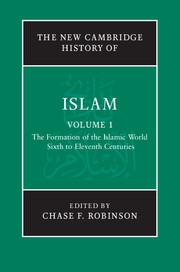Book contents
- Frontmatter
- Introduction
- PART I THE LATE ANTIQUE CONTEXT
- PART II UNIVERSALISM AND IMPERIALISM
- PART III REGIONALISM
- 10 Arabia
- 11 The Islamic east
- 12 Syria
- 13 Egypt
- 14 The Iberian Peninsula and North Africa
- PART IV THE HISTORIOGRAPHY OF EARLY ISLAMIC HISTORY
- Conclusion: From formative Islam to classical Islam
- Glossary
- Bibliography
- Index
- Plate Section
- References
10 - Arabia
from PART III - REGIONALISM
Published online by Cambridge University Press: 28 March 2011
- Frontmatter
- Introduction
- PART I THE LATE ANTIQUE CONTEXT
- PART II UNIVERSALISM AND IMPERIALISM
- PART III REGIONALISM
- 10 Arabia
- 11 The Islamic east
- 12 Syria
- 13 Egypt
- 14 The Iberian Peninsula and North Africa
- PART IV THE HISTORIOGRAPHY OF EARLY ISLAMIC HISTORY
- Conclusion: From formative Islam to classical Islam
- Glossary
- Bibliography
- Index
- Plate Section
- References
Summary
The history of the Arabian Peninsula after the shift of the capital of the empire to Damascus is largely neglected by the universal histories. For example, al-Ṭabarī mentions in one line the conquest of Oman in 280/893, completely ignoring the major civil war that had led to it. Local sources for certain regions, such as Oman, Ḥaḍramawt and Najd, are very deficient as well. This fact is perhaps the reason for the assumptions sometimes voiced by modern scholars: that the central government was not interested in the Peninsula (except in the holy places), and that its history was largely tribal, cyclical and trivial. As will be shown below, these assumptions may be correct when applied to certain regions, such as Najd and Ḥaḍramawt, but not to others, such as Oman, Baḥrayn and the main parts of the Yemen.
Only a few generalisations may be made. The Peninsula never constituted one province, or one political unit, and its internal administrative and political divisions often changed. From the second/eighth century independent and semi-independent polities appeared, and regions underwent cycles of unification and fragmentation. Broadly speaking, society in Arabia, both settled and nomad, remained tribal, and ruling dynasties usually never became full-fledged states. The Peninsula in general lacked the features characteristic of other parts of the Islamic world, namely, court society, sophisticated central bureaucracy, highly developed civilisation and a fixed system of raising standing armies. Apart from that, there were great differences between the various regions.
- Type
- Chapter
- Information
- The New Cambridge History of Islam , pp. 395 - 447Publisher: Cambridge University PressPrint publication year: 2010
References
- 1
- Cited by

